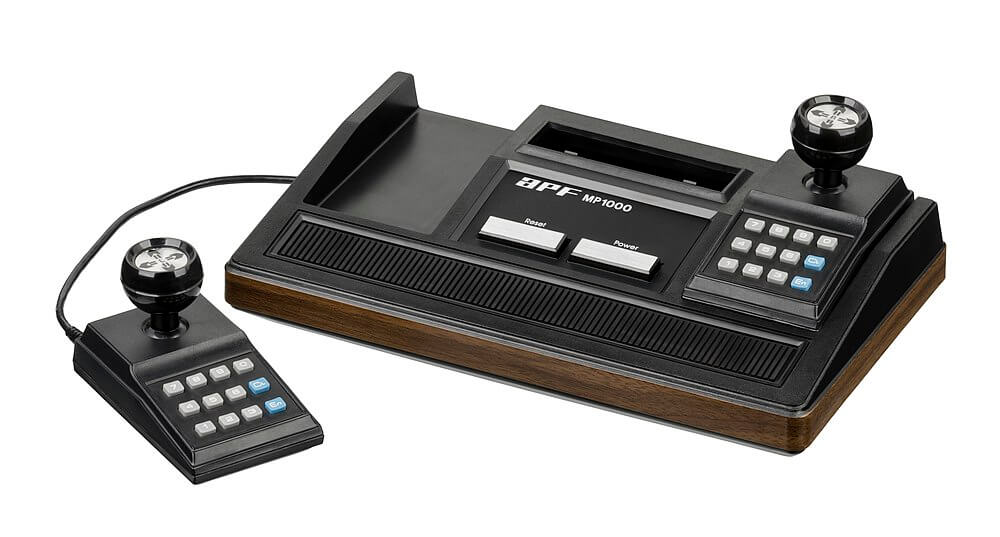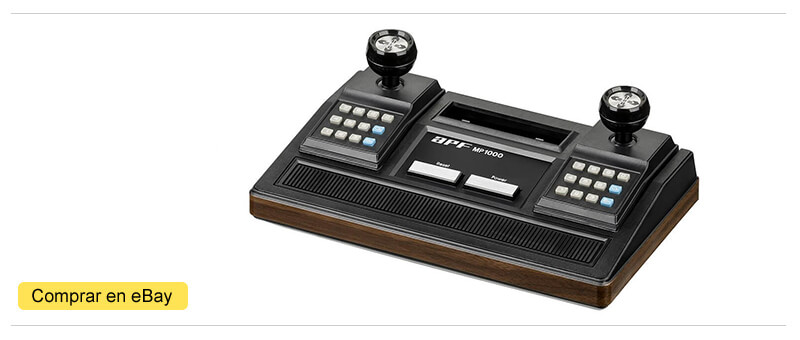The APF-M1000 and APF-MP1000 is the second generation console that the North American company APF Electronics Inc, a company created by the brothers Al & Phil Friedman, designed to face the then all-powerful Atari 2600.
The APF-M1000/APF-MP1000 retro video game console had an 8-bit CPU inside and incorporated the new cartridge format, a revolution in an era previously marked by dedicated Pong-type consoles. Video games as we know them today came with this new generation.
| COMPANY: | APF Electronics Inc |
| CONSOLE GENERATION: | 2ND GENERATION OF CONSOLES |
| RELEASE DATE: | 1978 North America |
| GAMES CATALOG: | Official 13 on BASIC +1 cartridge (including the APF Imagination Machine). |
| LAUNCH PRICE: | US$ 129.95 // US$ 599 the APF Imagination Machine |
| PROCESSOR: | Motorola 6800 8-bit |
| FORMAT: | Cartridge |
| BUY IT ON EBAY: | https://ebay.us/lqMJng |
- History of the APF-M1000 and APF-MP1000.
- APF Imagination Machine
- Price of an APF-MP1000 console. How much?
- Collect the APF-M1000 and APF-MP1000.
- Buy an APF-MP1000.
- TOP Retro: Best games of the APF-MP1000.
- FAQ APF-M1000 and APF-MP1000.
- Technical characteristics of the APF-M1000 and APF-MP1000
History of the APF-M1000 and APF-MP1000 Console
Almost half a century after its launch, few people remember the APF-M1000 and APF-MP1000 retro console. It’s normal, there are few players who enjoyed it at the time compared to other systems, and even fewer active players on social networks who continue to share their experiences with this machine. Unfortunately, the almighty Atari 2600 monopolizes all our memories of the second generation of consoles, eliminating from our imagination such interesting consoles as the APF-M1000 and APF-MP1000.
The first thing you may be wondering is why we refer to this retro console with two names, M1000 and MP1000, the answer is simple and surprising at the same time: Being exactly the same console, the APF M1000 version was sold separately as a independent video game console and the APF MP1000 was part of the APF Imagination Machine combo, a real freak that we’ll talk about later.
Clarified this point, let’s meet one of the many forgotten consoles of the second generation of consoles.
APF-M1000 and APF-MP1000 Background and Context
The 70’s were frenetic years in the video game industry, a new market was created out of nowhere and commercial video games reached the general public mainly through two systems: arcade machines and video game consoles (there were still a few years to go). for the arrival of microcomputers).
Although it is true that during the first years PONG and its variants monopolized the market, engineers quickly devised new systems to stand out from the competition in arcade machines, the Atari company being one of the most prolific and innovative. In this way, the first genres of video games as we know them today emerged and settled: sports, driving, aliens…
This evolution, which was consolidated in the arcades in the mid-1970s, took a while to be reflected in our homes, the technology was excessively expensive and the heads of families at the time “only” had 1,200 models of different first generation video game consoles, but all of them being variants of Pong. Until the revolution came…
The Fairchild Channel F and its ROM cartridge… Launched in 1976, the Fairchild Channel F is the first second generation console, which adopted a new architecture that would become the reference for the following decades, in which the cartridge, making it possible to enjoy different interchangeable games and in turn creating a new market and industry, that of video games, not consoles (programming-manufacturing-logistics). Boom! Engineer Gerald “Jerry” Lawson had revolutionized the history of video games with his invention, the cartridge.
In this way, the second generation was light years away from the first taken over by Pong-type consoles… The cartridge, the new architecture and better performance due to the lower cost of microchips and other components, placed video game consoles at the “height” of the arcades and returned to be placed in the Top sales and lists of Three Kings / Santa Claus.

APF Electronics Inc, the family company of the brothers Al & Phil Friedman, which had initially been dedicated to importing calculators and electronic products from Japan and Hong Kong, already had experience in the new video game market with its APF TV Fun, First-generation dedicated console that, although it had not managed to unseat the Atari Pong, had a notable commercial success. Faced with this new scenario, a new opportunity had come for them, it was time to launch their new video game console…
APF-M1000 and APF-MP1000, the video game console.
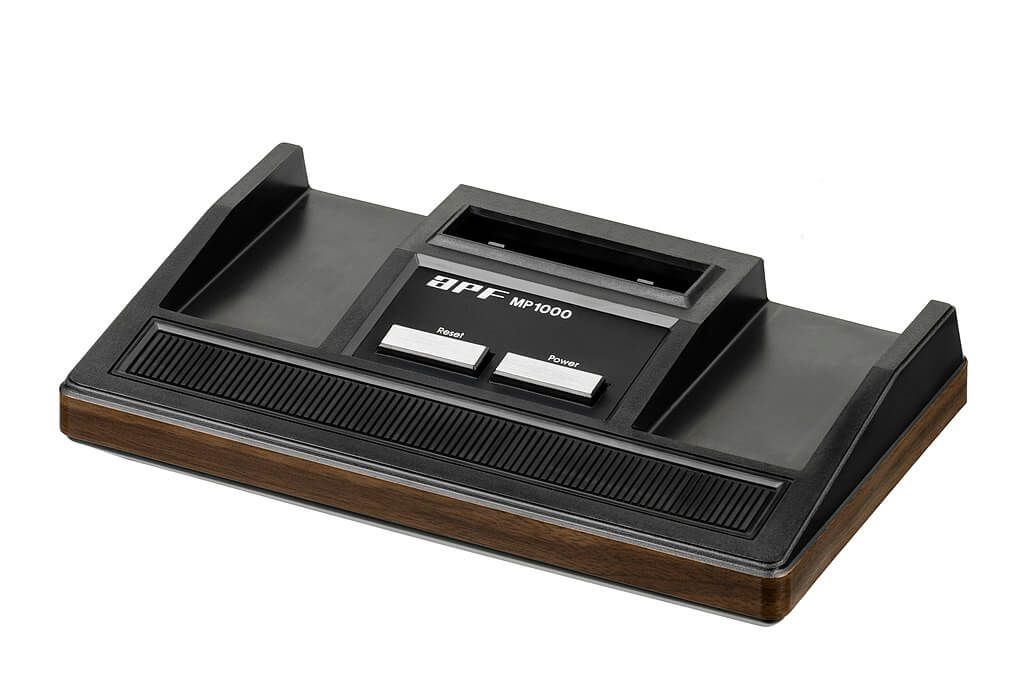
Launched in 1978, the development of the APF M-1000 and APF MP-1000 console took about 6 months from initial idea and concept to final design, involving APF engineers in the United States and Hong Kong, with whom they communicated Mainly by teletypes. The main design team was made up of four people and far from considering only the manufacture of a new console, its concept went much further, with the double intention of making the leap to the world of the PC.
From console to PC? Yes, APF originally designed its console to serve as the basis for its flagship peripheral, the APF Imagination Machine, transforming a second-generation console into a computer on par with its contemporaries. Hence, the chosen CPU was the 8-bit Motorola 6800, superior in graphics to the popular 6502. Regarding the console casing and joysticks, it was the APF factory in Hong Kong that was in charge of its design and manufacture, assembling it later and sending it to the United States to take care of the last steps and checks.
The console has a robust design in black and a wooden base, incorporating 2 joysticks with 1 fire button and 12 buttons, being very far from the knowledge of what “ergonomic” means. Fortunately and marking distances with many of the previous generation consoles, the controls are removable by cable. The console incorporated in memory the game Rocket Patrol.
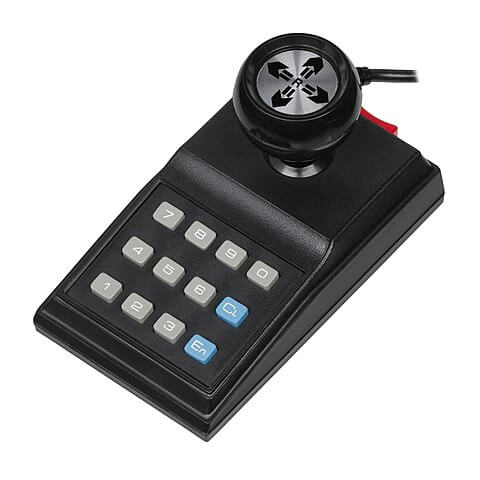
A total of 13 official cartridges were released for the APF console, all of them programmed and distributed by APF itself. These were the beginnings of video games and the optimal marketing of video game distribution that Atari would initiate had not yet been established and consolidated. The games are the following:
- Backgammon
- Baseball
- Blackjack
- Bowling/Micro Match
- Boxing
- Brickdown/Shooting Gallery
- Casino I: Roulette/Keno/Slots
- Catena
- Hangman/Tic Tac Toe/Doodle
- Pinball/Dungeon Hunt/Blockout
- Rocket Patrol (en memoria)
- Space Destroyers
- UFO/Sea Monster/Break It Down/Rebuild/Shoot
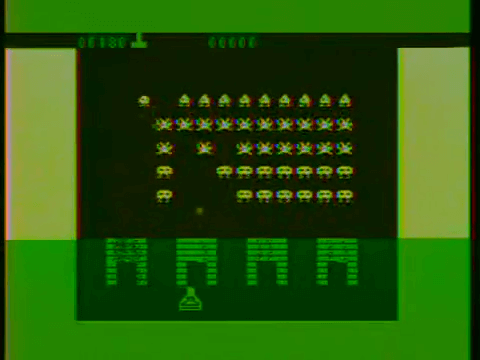
As you can see there were cartridges with multiple games, so the number of games is higher than the initial 13 cartridges. Highlight at this point the “inspirations” of some of the games such as Space Destroyers, which is a shameless copy of Atari’s Space Invaders.
The gaming experience, is it currently playable?
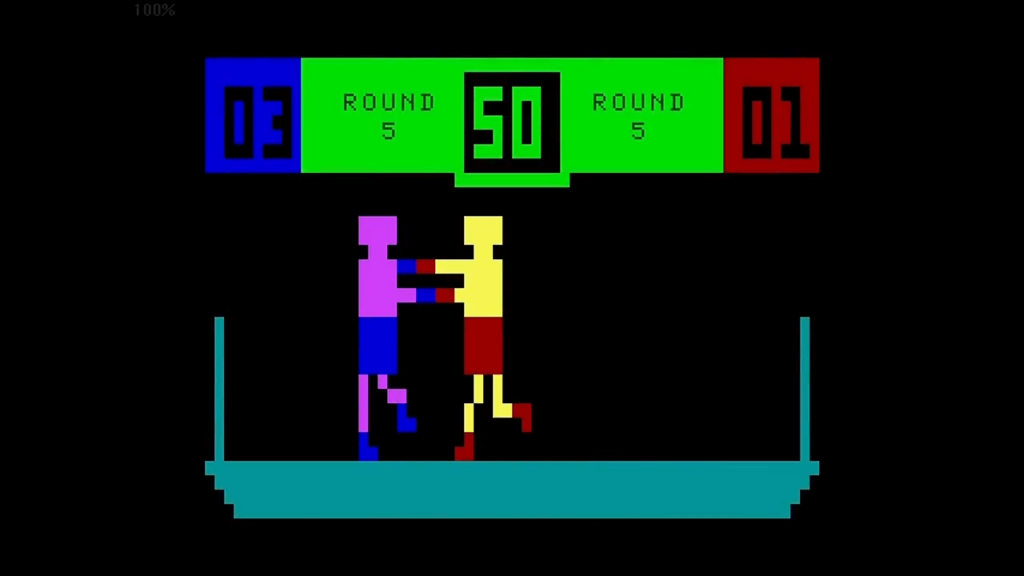
Since we have started updating the Infoconsolas website again, this is an essential section when analyzing a retro console: Can the APF M-1000 be played today? Are you enjoying yourself like before?
Collectibles aside, as with many of its contemporary consoles, the answer for most of us is a resounding NO. Sad, but I’m not going to lie to you, unless you have enjoyed it at the time and you have the nostalgia factor or you are old enough to have enjoyed consoles from the same period or earlier, the APFM-1000 games are not suitable for those of us starting with a ZX Spectrum, NES, Master System or later systems.
What has been said in this section does not detract from its value at all from the point of view of console collecting, but if your intention was to acquire an APF to play, consider very carefully if you meet the requirements.
The competition and decline of the APF-M1000 and APF-MP1000 console
The APF M-1000 was a console designed to fight the Atari 2600 both in its console version (the one known to all) and the combo/module project that would turn the Atari VCS into a home computer, a project that would never it was finished… To this day, wanting to confront the almighty Atari 2600 in those years may seem like real madness, quite audacity on the part of APF, but let’s remember that we are talking about the mid-70’s, the cake of video games was enormous and few imagined in 1976 and 1977 the impressive impact that the Atari machine would have. APF would present battle.
On this occasion, unlike the first generation of consoles, few were the companies that made the leap to the second generation and the use of the cartridge as a format. Technology had evolved a lot, greatly increasing the cost of research, development and manufacturing, now it was no longer enough to put an AY-3-8500 chip inside a casing as hundreds of companies and their consoles ventured dedicated Pong type. The second generation was a great filter and although there were few companies compared to the generation that took the step, the competition was much greater between the different consoles, since the components, architecture and video games really made a difference.
In this way, if APF was able to perfectly cope with consoles such as the RCA Studio II, Bally Astrocade or Fairchild Channel F, video game consoles with which it was on par, it could do little or nothing against the giant Atari and its prolific studios. internal and external developers, or against much superior machines such as Colecovision, Vectrex or Intellivision. The difference between launching a console in 1978 or 1980 was abysmal in terms of components and features, something that APF paid dearly for, with the aggravating circumstance of not having properly planned the launch of its video games, APF being the only developers… Blunder.
The console could not keep up with the pace of the new generation and industry, succumbing to the competition after a few years. Even so, APF had an ace up its sleeve as we will see below.
APF Imagination Machine
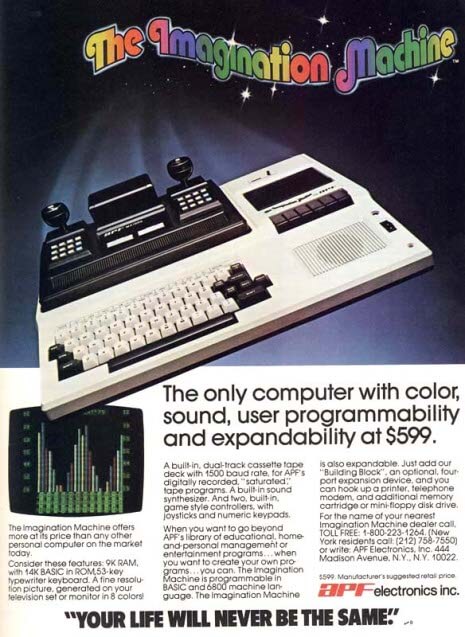
The APF Imagination Machine, the definitive module for our retro console, the expansion that turned a simple APF M-1000 or MP-1000 console into a powerful personal computer of the time. Suck that Bill Gates. Unstoppable.
And it is that they were other times, years in which the concept of video games and computing was not yet so defined, companies having the creative freedom and the difficulty of paving the way themselves, as new products were launched and clarifying the route to follow. It is possible that today we do not see much sense in it, but in a time when personal computers cost a million, taking advantage of the CPU of a console on a computer was not crazy…
Released at the end of 1979 at a price of US$599, the APF Imagination Machine extended the possibilities of our retro console to infinity (perhaps not so much):
It improved the features of the original machine, expanding the ROM (14 KB) and RAM (9 KB expandable to 17 KB), included keyboard, sound synthesizer, cassette player/recorder and the APF Basic. As peripherals, the RS232 base for storage cartridges, the storage disk unit, 8k expansion cartridges, a mini storage disk unit and a modem were launched... Yes, a modem. The result? Well, something as bizarre and as beautiful as this if we had the complete pack.

One of the most interesting aspects of the APF Imagination Machine is that, thanks to the inclusion of APF BASIC, users could program and share their own games and programs, something that in the late 70’s and early 80’s was one of the main reasons that existed to buy a family to buy a computer. Those were the years when parents began to think seriously about computing and programming as an important aspect in their children’s education.
In addition to being able to learn BASIC with the books that the systems themselves included (as many of us did with our ZX Spectrum), the magazines of the time shared code that users could chop up and record on tape, just as we older ones did of the place with the Microhobby and Micromania magazines. In this way, a submarket for the exchange of cassette tapes with homemade programs and games was added to the official games.
Retro Curiosity! APF corrected old mistakes with its APF Imagination Machine, in 1978 APF had launched its personal computer PeCos One (Personas Computer System), which included a keyboard, monitor and 2 cassettes. PeCos One was a notable failure largely because it included its own language instead of the already standardized Basic, PecOs 1. This fact was fixed in the APF Imagination Machine by including its own adapted version of Basic. Below is the cover of the APF personal computer manual.
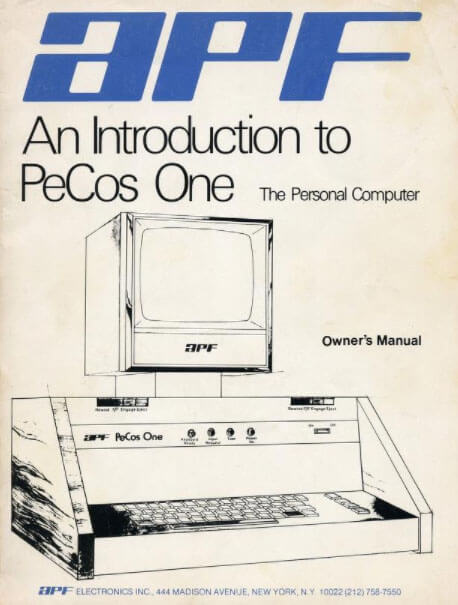
The reception of the press was quite positive, in 1978 for US$599 we obtained a computer with superior performance to the Apple II of 1977, which cost US$1,298 in its version with 4 KiB RAM, in addition to mounting a Motorola 6800 CPU instead of the 6502 that mounted the Apple II. Surprising as it may seem, the APF Imagination Machine was one of the cheapest ways to get into computing when it was released.
Having been launched at the end of 1978, in practice its commercial life began in 1979, its price and the good press it had in its beginnings could do little before the arrival of the microcomputers led by the Sinclair ZX80, new very economical machines that they democratized computing and that, unlike the APF TV Fun and most contemporary systems, they survived the great Crash of ’83. The APF Imagination Machine as well as the APF M-1000 and APF MP-1000 could not withstand this perfect storm falling hopelessly into oblivion
The price of the retro console APF-M1000 and APF-MP1000
Here you have a list with the launch prices of the consoles of the time, so that you can get a clear idea of the price of an APF M-1000 compared to other systems:
| CONSOLE | LAUNCH | PRICE | BRAND |
| Magnavox Odyssey | 1972 | US$99.9 | Magnavox |
| Tele-Games Pong | 1975 | US$98.95 | Atari |
| Atari Pong IV | 1976 | US$98.95 | Atari |
| APF TV Fun | 1976 | US$125 | APF |
| Coleco Telstar | 1976 | US$50 | Coleco |
| Fairchild Channel F | 1976 | US$169 | Fairchild Semiconductor |
| Atari 2600 | 1977 | US$199 | Atari |
| APF-MP1000 | 1978 | US$ 129.95 | APF |
| Bally Astrocade | 1978 | US$299 | Bally Manufacturing |
| RCA Studio II | 1978 | US$149 | RCA |
| APF Imagination Machine | 1979 | US$599 | APF |
| Intellivision | 1979 | US$275 | Mattel Electronics |
The jump from the first to the second generation consoles in terms of price was notorious, but it was totally justified. Within the second generation, we can see how the APF M-1000 was really cheap. We can assume that the manufacture of the console in the APF factory in Hong Kong had a lot to do with this.
Collect the APF M-1000 and APF MP-1000
Is it worth collecting an APF M-1000? Yes, it’s worth it. As we have already mentioned before, the APF retro console has become completely outdated in terms of gameplay, but from a collector’s point of view, it is a very interesting unique second-generation console, a worthy rival to Atari that became a personal computer capable of rivaling Apple.
Obviously, it will be the retro collectors who are interested in this system, for generalists an Atari 2600 or Colecovision is more than enough to represent the 2nd generation of consoles, but for those who want to delve into the second generation of consoles, this console It is essential due to the few consoles that were launched on the market from different brands in the 2nd generation. Plus, getting all your games is literally at your fingertips.
Buy an APF-M1000 and APF-MP1000
If it has already become clear that this console is essential for collectors of retro consoles, now the question is where to buy an APF M-1000? How much does an APF MP-1000 cost? Fortunately for us, currently the “retro” fever has not yet reached this system, in the link below you can see the current prices of the consoles and games available on eBay right now (2021), you will be surprised.
The good thing, the console and the games are sold for prices that range between 15 and 30 euros depending on their condition, the negative? As you may have seen, there are very few units. Being a console of limited sales, more than 40 years after its launch, fewer and fewer consoles appear in the “back of the closet”, today the APF-1000 are mostly in the hands of collectors who do not plan to sell them. , so if you are interested in acquiring one, do not take long to decide!
STOP COLLECTOR! If you’ve seen the console listing on eBay, I want to say THANK YOU. Since 2004, the objective of Infoconsolas is to contribute to preserving the history of consoles and video games through our own collection of systems and the hours of work invested in this very website.
Being an eBay partner listing, if you buy a game or console, you will be helping Infoconsolas in the preservation of video game culture, so thank you very much again!
TOP: Best retro console games APF
Being a console with 13 official cartridges, it makes little sense to make a selection of the best games, so at Infoconsolas we have thought that it would be better to show all the existing ones. In the following YouTube video you can see all the commercial games of the APF-M1000 console, we hope you like them!
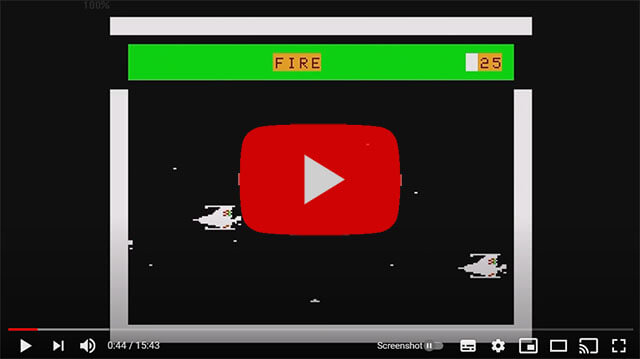
FAQ APF-M1000 and APF-MP1000
Here you have the most frequent curiosities, questions and answers of the retro console APF M-1000 and APF-MP1000, little by little we will expand this section:
In April 1978.
To the second generation of video game consoles.
Unlike its predecessors, it is a non-dedicated cartridge console.
2 models.
Official 13 on cartridge plus 1 BASIC cartridge (including the APF Imagination Machine).
It is the name of the founders of the company APF Electronics Inc, the brothers Al & Phil Friedman.
No, in this generation cable was already available.
The console has 2 controllers but some games were for 4 players.
No, it’s all plastic, including its base
Yes, the Rocket Patrol.
Yes, the APF TV Fun.
No.
It had an 8-bit Motorola 6800 CPU.
After 7 minutes of inactivity, the console stops sending a signal to the television, it was a security system to avoid stains on the televisions of the time.
3 months.
Technically it would be a peripheral.
Technical characteristics of the APF-M1000 and APF-MP1000
Below we show the technical characteristics of the APF-M1000 and APF-MP1000:
- Processor: Motorola 6800 CPU.
- RAM Memory: 1KB
- Graphics chip: Motorola 6847P.
- Resolutions: 256×192 at 4 colors // 128×192 at 8 colors.
- Format: ROM cartridges.
- Housing: RESET and POWER buttons.
- Controls: Joystick 1 shot and 12 buttons.
- TV output: NTSC TV modulator.
- Power supply: 7.5V AC/0.8 Amps or 12V DC/0.5 Amps.
- Weight: 3 3/4 lbs.
- Measurements: L7″ xH 4 1/2″ xW11 1/2″.

